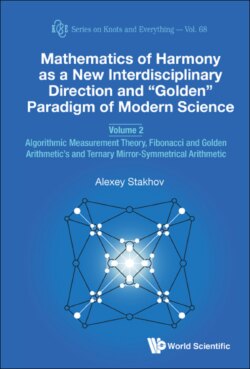Читать книгу Mathematics of Harmony as a New Interdisciplinary Direction and “Golden” Paradigm of Modern Science - Alexey Stakhov - Страница 29
На сайте Литреса книга снята с продажи.
1.10. Optimal (n, k, 1)-Algorithms Based on Arithmetic Square 1.10.1. Synthesis of the optimal (n, k, 1)-algorithm
ОглавлениеNow, we synthesize the optimal (n, k, 1)-algorithm [16]. Let’s recall that the restriction S = 1 means that indicatory elements (IE) move along segment AB only in one direction: from point A to point B. This means that if some IE at a certain step turned out to the right of point X, then this IE “leaves the game”, i.e., it cannot be used further in the measurement process.
The above “counting” algorithm (Fig. 1.5), underlying the “Euclidean definition” of the natural number (1.10), is a vivid example of the restriction S = 1.
Let us carry out the same reasoning as for the synthesis of the optimal (n, k, 0)-algorithm. Suppose that for some n and k, there exists the optimal (n, k, 1)-algorithm that realizes on the segment AB the (n, k)-exactness equal to F(n, k). In other words, the optimal (n, k, 1)-algorithm divides the segment AB into F(n, k)equal intervals of the unit length Δ = 1, that is,
Now, let the first step of the optimal (n, k, 1)-algorithm on the segment AB be in the enclosing the k indicatory elements to the points of the segment AB, as shown in Fig. 1.9.
Fig. 1.9. The first step of the optimal (n, k, 1)-algorithm.
After the first step, on the basis of the indications of k IE, the (k+1)th situations may arise:
where
Now, let’s analyze the situations that may arise after the first step of the (n, k, 1)-algorithm.
Let’s consider the first situation X AC1 among the situations (1.25). For this situation, all k IE turned out to be to the right of point X. This means that, according to the restriction S = 1, none of the k IE can be further closing to the interval AC1,that is, the measurement actually ends after the first step because all IE turned out to the right of point X. But, according to our “inductive hypothesis”, the optimal (n, k, 1)-algorithm “divides” the segment AB into F(n, k) equal parts of the unit length Δ = 1. Then, it follows from this reasoning that the first uncertainty interval AC1 must be the segment of the unit length Δ = 1, that is,
Let’s now consider the second situation X C1C2 among the situations (1.25). In this situation, after the first step, we have the (n – 1) steps and one IE, which is to the left of the point X;all other IE are to the right of point X and, according to the restriction S = 1, cannot participate in the measurement process. Then we can apply to the segment C1 C2 the optimal (n – 1, 1, 1)-algorithm, which, according to the “inductive hypothesis” (1.24), divides the segment C1C2 on the F(n –1, 1) equal parts of the unit length Δ = 1, that is,
Let’s now consider the situation X Cj Cj+1 among the situations (1.25). In this situation, we have the (n – 1) steps and j IE, which are to the left of point X (all other (k – j) IE are to the right of point X and, according to the restriction S = 1, cannot participate in the measurement process). Then we can apply to the segment Cj Cj+1 the optimal (n – 1)-algorithm, which, according to the “inductive hypothesis” (1.24), divides the segment CjCj+1 on the F(n –1, j) equal parts of the unit length Δ = 1, that is,
Finally, in the last situation X CkB among the situations (1.25), all the k IE are to the left of point X; this means that we can enclose to the segment CkB the optimal (n– 1, k, 1)-algorithm, which, according to the “inductive hypothesis” (1.24), divides the segment CkB on the F(n – 1, k) equal parts of the unit length Δ = 1, that is,
Taking into consideration the relation (1.26), as well as the expressions (1.27)–(1.30), we can write the following recurrent relation for the (n, k)-exactness of the optimal (n, k, 1)-algorithm:
Now, we consider the sum:
taken from the expression (1.31). According to the recurrent formula (1.31), the sum (1.32) is equal to F(n, k – 1), that is,
By using (1.33), we can simplify the recurrent relation (1.31) and write it in the following compact form:
Now let’s construct the table of the numbers of F(n, k)by using the recurrent formula (1.34). To do this, we find out the extreme values of the function F(n, k), corresponding to the values n = 0 and k = 0, that is, the values of F(0, k) and F(n, 0). Recall that F(0, k)is the (0, k)-exactness of the optimal (0, k, 1)-algorithm, and F(n, 0) is (n, 0)-exactness of the optimal (n, 0, 1)-algorithm. But, according to our definitions, (0, k, 1)-algorithm is the (n, k, 1)-algorithm, in which the number of steps is equal to n = 0, and (n, 0, 1)-algorithm is (n, k, 1)-algorithm, in which the number of IE is equal to k = 0. But, from the “physical” sense of the task, the (n, k, 1)-algorithms, in which either n = 0 or k = 0, cannot narrow the initial uncertainty interval, and therefore, for such (n, k, 1)-algorithms, the (n, k)-exactness or efficiency function is always identically equal to 1, that is,
